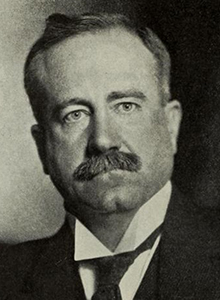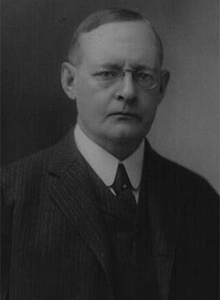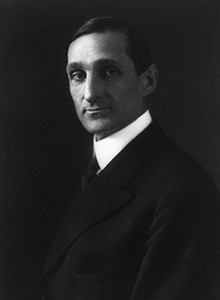
John Skelton Williams
- Ex Officio Member, Board of Governors, 1914–1921
- Born: July 6, 1865
- Died: November 4, 1926
John Skelton Williams served as comptroller of the currency and an ex officio member of the Federal Reserve Board from 1914 to 1921. As comptroller, Williams was one of the three members of the Reserve Bank Organization Committee, which under the Federal Reserve Act was responsible for determining the number and location of Federal Reserve Banks and the boundaries of Federal Reserve districts.
Williams was born in Powhatan County, Virginia, in 1865. After receiving his education at the University of Virginia, he became a railroad executive and then an increasingly influential banker.1 In April 1913, President Woodrow Wilson appointed him to the office of first assistant secretary of the Treasury. One of his first acts was to order the segregation of work areas at the Bureau of Engraving and Printing, part of the Treasury under his authority.*2
In January 1914, President Wilson named Williams the comptroller of the currency, and he took office February 2.3 On August 10, 1914, Williams became an ex officio member of the new Federal Reserve Board, where he served along with Secretary of the Treasury William McAdoo and the five newly appointed Board members. Williams served as comptroller for the entirety of World War I. As comptroller, Williams was aggressive in his oversight of the banking industry and was often at odds with the Fed.4
Williams was reappointed by President Wilson in 1919. His nomination was strongly opposed by House Banking committee chairman Louis McFadden5 (who would later sponsor the McFadden Act) among others. Hearings on the nomination lasted nearly a month6 and included an investigation of Williams's involvement in the Office of the Comptroller's 1915 legal case against Riggs National Bank.7 Despite controversy, his renomination was approved.
During the recession of 1920-1921, Williams recommended specific discount window policies for the Federal Reserve Banks but the Banks did not act on his advice.8 He resigned as comptroller on March 2, 1921. After leaving public service, he went on to be an outspoken critic of the Federal Reserve.9 His charges that the Federal Reserve had deliberately created deflation to hurt the interests of farmers and small banks led to the formation of a congressional joint committee to investigate the matter.10
Williams died in 1926.
* To our readers: This website provides information about individuals who played important roles in Federal Reserve history, some of whom embraced, advocated, or advanced public policies that are wholly inconsistent with our values. This profile and others on this website acknowledge these problematic views and actions. The Federal Reserve History website is committed to transparency in documenting the stories that Fed history reveals and doing so in a manner that is consistent with the Federal Reserve’s commitment to education, diversity, equity, and inclusion.
Endnotes
- 1 "A Guide to the John Skelton Williams Papers, 1884-1926." University of Virginia Library, 2002.
- 2 Yellin, Eric Steven. Racism in the Nation's Service: Government Workers and the Color Line. UNC Press, 2013, pp. 117–9, 123–4, and Desmond King. Separate and Unequal: African Americans and the US Federal Government. Oxford University Press, 2007, pp. 3, 29.
- 3 "John Skelton Williams: 13th Comptroller of the Currency." Office of the Comptroller of the Currency, n.d.
- 4 Robertson, Ross M. The Comptroller and Bank Supervision: a Historical Appraisal. Office of the Comptroller of the Currency, 1968, p. 113.
- 5 "Williams Denies that he Took a Fee." The New York Times, July 22, 1919.
- 6 Nomination of John Skelton Williams. Hearing before the Committee on Banking and Currency, United States Senate, first session. Government Printing Office, 1919.
- 7 Kane, Thomas P. The Romance and Tragedy of Banking: Problems and Incidents of Governmental Supervision of National Banks, vol. II. The Bankers Publishing Co., 1922.
- 8 Meltzer, Allan H. A History of the Federal Reserve, vol. 1. University of Chicago Press, 2003, p. 104.
- 9 See, for instance, "N.Y. Reserve Bank Salaries Attacked." The New York Times, October 18, 1921, and his correspondence with Congress, such as the letter printed in the Congressional Record of July 27, 1922 (p. 10686).
- 10 Meltzer, p. 127.
Written by the Board of Governors of the Federal Reserve System. Updated September 2021 by Genevieve Podleski. See disclaimer.



